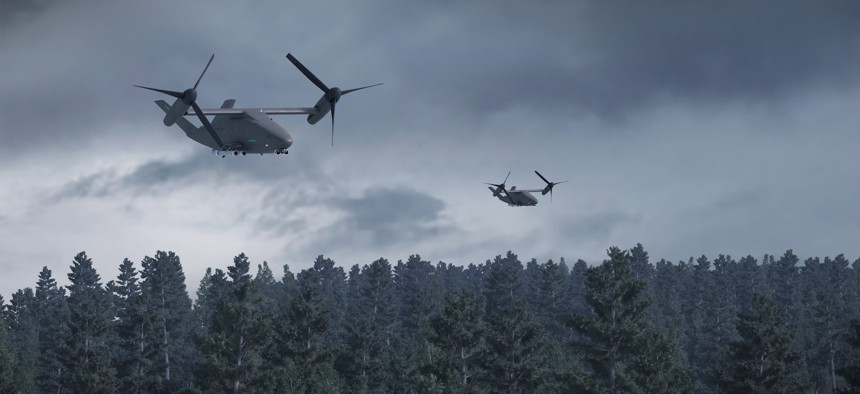
Boeing is designing a tiltrotor drone wingman concept to support the Army’s helicopter fleet, similar to the Air Force’s push for collaborative combat aircraft, as the Army rushes to field unmanned drones.
Renderings for the CxR aircraft revealed by Boeing on Monday at the Association of the U.S. Army’s conference in Washington. The company’s pitch would place unmanned vertical-takeoff-and-landing aircraft alongside Army helicopters in combat and cargo operations.
“We see a lot of demand in that RSTA mission: reconnaissance, surveillance, target acquisition and attack,” Chris Speights, chief engineer for Boeing’s vertical lift division, told Defense One on the sidelines of AUSA. “How the Army is using the Apache is evolving. We expect it to continue to evolve, and this gives them options and flexibility with how they conduct those missions going forward.”
Boeing’s push to design an Army-focused drone wingman follows the Air Force’s progress on fielding its own collaborative combat aircraft. Company engineers said that effort, along with its own MQ-28 Ghost Bat drone wingman program for the Royal Australian Air Force, informed their concept.
“It’s definitely relevant,” Speights said of those CCA programs. “We actually expect to leverage a lot of those lessons learned, even some of the core technologies around the autonomy and mission capability, we expect to leverage those on the CxR.”
Speights said the CxR aims to be in the group five category of drones, weighing in between 5,000 to 7,000 pounds with the ability to carry between 1,000 and 2,000 pounds of payload.
Last year, the Army scrapped plans for its Future Attack Reconnaissance Aircraft, or FARA, program due in part to a pivot to unmanned systems. Army Secretary Dan Driscoll proposed a sweeping transformation initiative earlier this year highlighting the need for autonomous systems.
“When we look at those FARA requirements, I think this lines up really well with what the customer was seeing … but with much better affordability,” Speights said. “We’re looking at mission sets and capability gaps.”
Renderings of the CxR show a profile similar to Boeing’s V-22 Osprey, a manned tiltrotor aircraft flown by multiple service branches. Osprey variants have been plagued by historic mishaps including 65 deaths since the 1990s, and the program has grappled with longstanding gear and engine issues. Speights said the CxR would be run on a single gas turbine engine, unlike the V-22.
“This architecture will have a simplified approach,” Speights said. “We would centralize the propulsion system so you would have a very simple set of drive shafts and gearboxes that transmits power to the rotors.”
Boeing’s competitors are also touting their recent ambitious unmanned projects. Last week, Sikorsky announced NOMAD, its offering of a rotor blown wing vertical take-off and landing drone. The Lockheed Martin subsidiary also unveiled a pilot-less UH-60L helicopter at AUSA for unmanned cargo missions.
The post Boeing unveils concept for Army unmanned tiltrotor aircraft amid military push for drones appeared first on Defense One.




